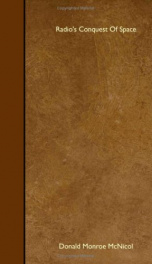radios conquest of space

Preface In this work the author makes no attempt to romantiiize the history of radio. Rather, radio is treated as a great new utility created by men of genius who hkarkened less to outside inspiration than to voices within themselves men and boys of pioneering spirit who through enthusiasm and diligence studied and experimented, often with meager equipment, until desired results were attained. The work supplies a readable record of radio achievement having somewhat chronological treatment, which will enable radio workers to live over again days and nights of attachment to a labor that held their interest constant. The book, without mathematics, presents a narrative of experimental achievement which boys and young men will find stimulating, while at the same time they acquire a knowledge of how radio started and how it grew. The layman, also, by perusing this work may learn how radio operates, since the knowledge of its construction and working today is built up from its elementary beginning. And, because of the manner in which the various scientists, engineers, and experimenters are identified, the reader may recognize the many consecutive contributions as achievements of real people. DONATB M CNICOL. Roselle Park, New Jersey. Acknowledgments For the privilege of using portions of technical articles written by the author and published in Radio Engineering, Projection Engineering, and Communicatiom magazines, my thanks are extended to the Bryan Davis Publishing Company, New York, and to Lewis Winner, editor. In appreciation of like permission to abstract from articles contributed to Telegraph and Telephone Age, thanks are extended to Car1 A. Nelson, publisher. To George H. Clark, of the Radio Corporation of America, New York, the author is indebted for certain photographs and other illustrations, and for many hours of agreeable discourse on radio historical matters. And to Alfred A. Ghirardi, radio author and engineer, New York, thanks are due for consultation and for typescript reading. Contents . . t t PAGE . v ACKNOWLEDG. MENTS , i vii -. I CHAPTER I 1 I 1. ELE ICIT T Y HE , FORERUNNE I R I 3 CHAPTER PAGE 19. THE PROBLEM OF ATMOSPHERINCO ISE 206 20. THE A UDIONA PPLIED T O WIRE T ELEPHONY 218 RADIOS CONQUEST OF SPACE Electricity, the Forerunner Like many other epochal achievements the conquest of space by radio was begun on a small scale, with mLager knowledge and with improvised tools. As far back as the year 1820, a scholarly Dane of melancholy mien bridged space when he observed that by excited gesticulations a magnetic needle was endeavoring to announce the receipt of a momentous message from an electrically charged wire a short distance away. And now, in the year 1945, the world is geared to a variety of radio services. Not many occupations nor many private or public services have missed the revolutionizing influences of signaling through space. There is substance in the view that radio came into the hands of men somewhat suddenly for, considered in the range of the centuries, a generation of time may be marked off as a small measure, as a brief period. The suddenness of the advent of radio and the unprornising evidences with which it first attracted attention very likely were reasons why men and boys used it as a toy during about half the years the art was growing from an idea to a dominant force in the affairs of nations, industries, education, and entertainment...
Info about the book
Author:
Series:
Unknown
ISBN:
0815323778
Rating:
2.5/5 (4)Your rating:
0/5
Languge:
English
Users who have this book
Users who want this book
What readers are saying
What do you think? Write your own comment on this book!
write a commentif you like radios conquest of space try:
Other books by this author
Do you want to read a book that interests you? It’s EASY!
Create an account and send a request for reading to other users on the Webpage of the book!


